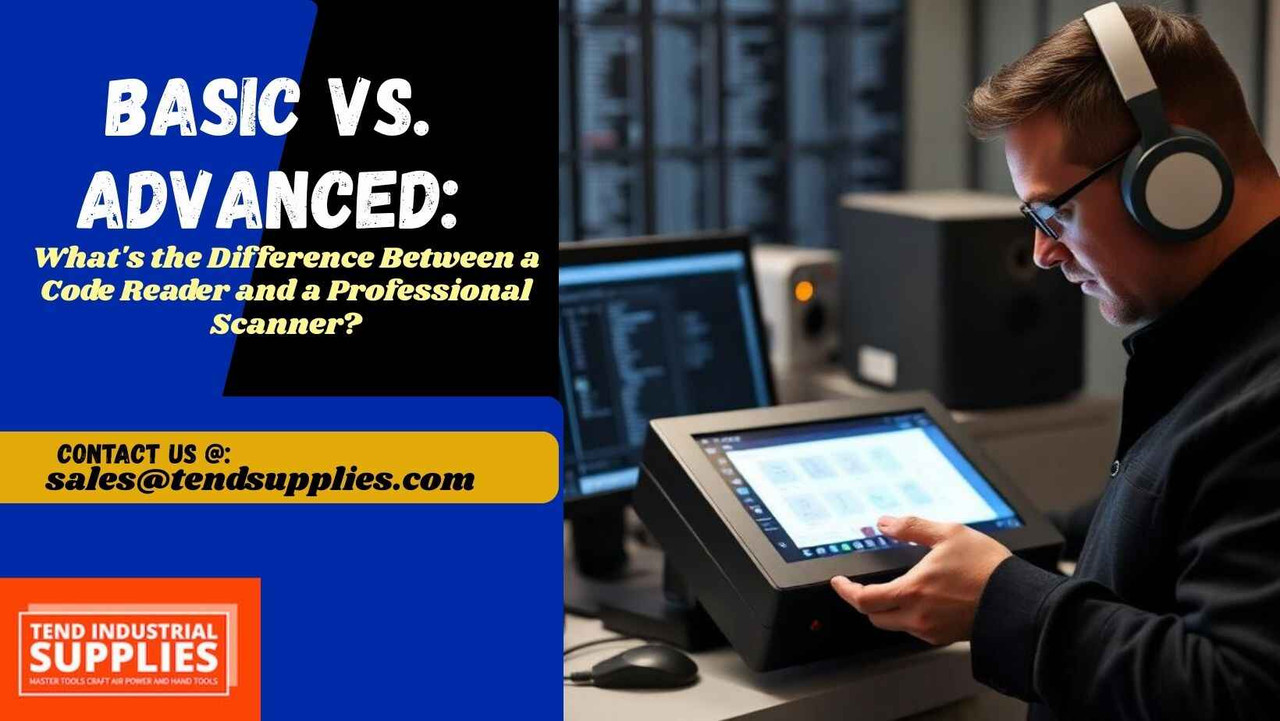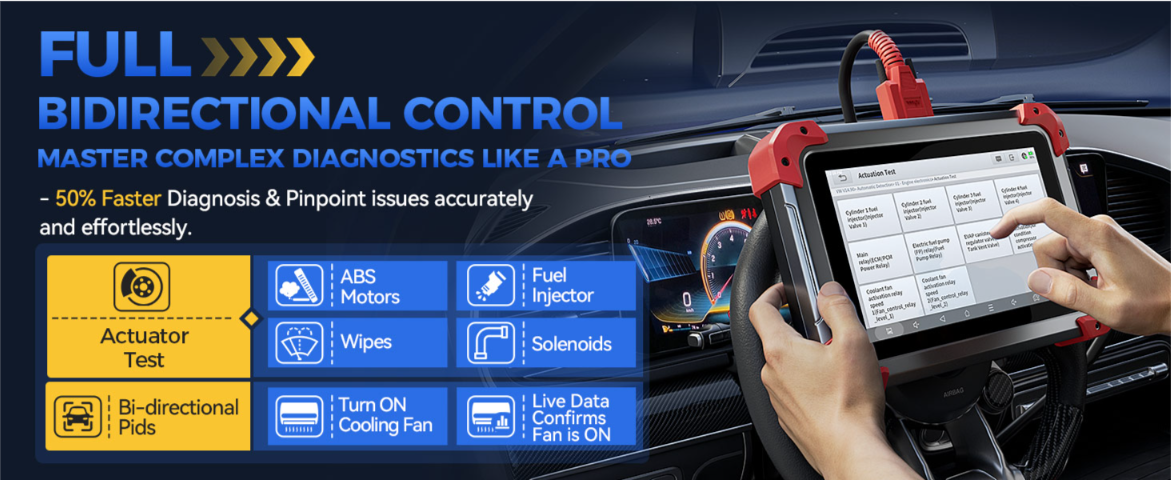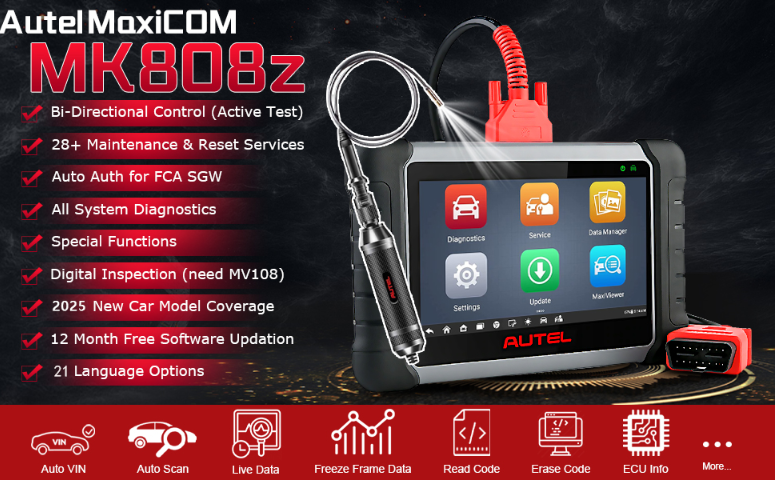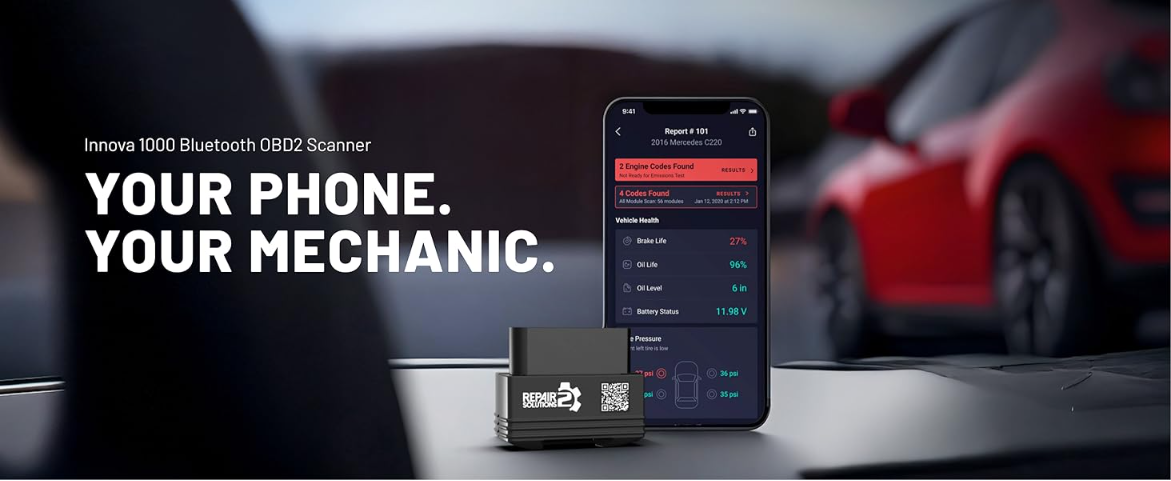Basic vs. Advanced: What's the Difference Between a Code Reader and a Professional Scanner?
On a rainy Friday evening, Daniel was driving home when the dreaded Check Engine Light flickered on. His heart sank. Was it a loose gas cap, or the beginning of an expensive repair? Grabbing the small code reader he kept in his glove box, he plugged it into the OBD2 port. It gave him a code, but no real answers. The next morning, his mechanic connected a far more powerful diagnostic scanner, and within minutes revealed the exact cause of the issue.
This everyday scenario captures why understanding automotive diagnostic tools truly matters. And that’s exactly what this guide, “Basic vs. Advanced: What’s the Difference Between a Code Reader and a Professional Scanner?” aims to clarify. Whether you're a casual car owner or a hands-on DIY mechanic, knowing the difference between these two tools can save you time, money, and a lot of uncertainty. In the sections ahead, you'll learn how each tool works, what they can and cannot do, and how to choose the right one for your needs in 2025 and beyond.
Quick Answer
A basic OBD2 code reader only reads and clears engine-related trouble codes, making it ideal for simple Check Engine Light diagnostics. A professional automotive scanner offers advanced features, including live sensor data, ABS/SRS diagnostics, bidirectional control, and system resets, making it the best choice for serious DIYers and mechanics.
Amazon Affiliate Disclosure:
Tend Supplies is a participant in the Amazon Services LLC Associates Program, an affiliate advertising program designed to provide a means for sites to earn fees by linking to Amazon.com and affiliated sites. As an Amazon Associate, we earn from qualifying purchases. We only recommend products we genuinely believe in, which helps us continue to create valuable content for our readers.
Key Takeaways:
-
Basic code readers only read and clear engine/transmission codes.
-
Professional scanners diagnose all vehicle systems, ABS, SRS, BCM, HVAC, and more.
-
Live data and graphing are exclusive to advanced scanners.
-
Bi-directional tests and service resets (oil, EPB, SAS) require a professional scanner.
-
Choose based on your goals: basic troubleshooting vs. full diagnostic capability.
The Core Difference: "Reading" vs. "Talking"
To understand the price gap, you must realize Bi-Directional Control.
-
Basic Code Reader (Passive): Think of this as a thermometer. It can indicate the patient has a fever (showing a code), but it can't explain why or address it. It only "reads" data sent by the car's computer (ECU).
-
Professional Scanner (Active): Think of this as a doctor. It not only sees the fever but can ask the patient to "cough" (active test). A pro scanner is Bi-Directional, meaning it can send commands to the car.
-
Example: Your window won't roll up. A code reader tells you nothing. A pro scanner lets you press a button on the screen to force the window motor to move. If it moves, the motor is fine, and the switch is broken. You just saved hours of diagnosis.
-
What Is a Basic OBD2 Code Reader?
An introductory OBD2 code reader is the simplest tool for reading and clearing Diagnostic Trouble Codes (DTCs) from your vehicle’s Engine Control Unit (ECU). It’s ideal for quick, entry-level checks.
Core Functions (What It CAN Do)
-
Read & clear engine codes: Displays generic codes like P0171 or P0420.
-
Show freeze frame data: Snapshot of engine RPM, speed, temperature at the time the code was thrown.
-
Check emissions readiness: See I/M monitor status before an emissions test.
Key Limitations (What It CANNOT Do)
-
No live sensor data
-
No ABS/SRS/TPMS/BCM access
-
No system tests or reset functions
-
No bi-directional control (cannot command components)
Who Should Use a Code Reader?
-
Beginner DIYers
-
Everyday drivers
-
People checking a used car before purchase
-
Anyone who only needs quick diagnostics for the Check Engine Light
When to Buy a Basic Code Reader
Best For: Daily Drivers, Used Car Buyers, "Check Engine" Light anxiety.
You only need a basic reader if:
-
You need to pass inspection: verify your car is "Ready" for the smog test.
-
You want to avoid mechanic dishonesty: Know the code (e.g., "O2 Sensor") before walking into a shop so you don't get upsold.
-
Budget is priority: You can grab a solid tool like the Autel AL319 or a simple Vevor OBD2 Reader for the price of a few coffees.
When to Buy a Professional Scanner
Best For: DIY Mechanics, Flippers, Car Enthusiasts.
You need a pro scanner if:
-
You do your own brake jobs: Modern cars with electronic parking brakes require a scanner to retract the calipers. You literally cannot change pads without one.
-
You are fixing a specific system: If the ABS, Airbag (SRS), or Transmission light is on, a basic reader will show "No Codes Found." Only a scanner can read these modules.
-
You need to "Re-learn" parts: Replaced a throttle body or battery? The car won't run right until you "teach" the ECU the new part exists using a scanner.
Top 3 Picks for 2025
1. XTOOL D7 Bidirectional OBD2 Scanner
A powerful professional tool with more than 36 reset functions, wide vehicle coverage, and advanced calibrations like injector and throttle relearn. Excellent for serious DIYers and independent shops.
Pros:
-
Full-system diagnostics
-
Bi-directional tests
-
36+ service functions
-
FCA, CANFD & DoIP support
Cons:
-
More features than beginners may need
-
Slightly larger learning curve
2. Autel MaxiCOM MK808Z with MV108S Endoscope
A professional-grade scanner with a built-in endoscope for visual inspections. All systems covered plus ergonomic design and premium support, ideal for serious techs and frequent users.
Pros:
-
OEM-level diagnostics
-
Included inspection camera
-
Intuitive interface
-
Broad vehicle compatibility
Cons:
-
Higher price point
-
Extra accessories add weight
3. Innova 1000 Bluetooth OBD2 Scanner
Perfect for drivers and DIYers who want a mobile app experience. Syncs with iPhone & Android, making it easy to read and clear codes, view data, and store reports right on your phone.
Pros:
-
Bluetooth connectivity
-
Intuitive phone app
-
Great for basic and intermediate diagnostics
-
Affordable
Cons:
-
Not as robust as professional scanners
-
Fewer advanced service functions
What Is a Professional Automotive Scanner?
A professional scanner is a full diagnostic interface capable of reading all systems, running active tests, and performing service functions for in-depth repair tasks.
Advanced Capabilities (What Sets It Apart)
-
Full-system diagnostics: Engine, transmission, ABS, SRS, BCM, HVAC, and more
-
Live data streams: Real-time sensor data and graphs
-
Bi-directional control: Activate fans, cycle ABS pumps, test injectors
-
Maintenance resets: Oil light, EPB, SAS, DPF regen, battery registration
-
Reads manufacturer-specific codes (not just generic P-codes)
Who Should Use a Professional Scanner?
-
Serious DIYers
-
Professional mechanics
-
Shops that service multiple brands
-
Anyone diagnosing complex issues beyond the engine
These features make professional scanners ideal for troubleshooting and accurate repairs.
Find the Right OBD2 Tool for Your Vehicle (Best Picks on Amazon)
Whether you’re a weekend DIYer or a seasoned tech, choosing the right diagnostic tool can mean the difference between guessing and knowing. Below are the Top 3 Scanners you can buy today, fast shipping and trusted performance.
Best OBD2 Diagnostic Tools on Amazon
| Product | Key Strength | Shop Now |
|---|---|---|
| XTOOL D7 Bidirectional OBD2 Scanner | Full-system pro-level diagnostics + 36+ resets | Buy on Amazon |
| Autel MaxiCOM MK808Z w/ MV108S Endoscope | All-system OEM-level scanner + built-in endoscope | Buy on Amazon |
| Innova 1000 Bluetooth OBD2 Scanner | Beginner-friendly Bluetooth tool for phones | Buy on Amazon |
Scanner Comparison Table
| Feature | XTOOL D7 | Autel MK808Z + Endoscope | Innova 1000 |
|---|---|---|---|
| Full System Diagnostics | ✅ | ✅ | ⚠️ (Limited) |
| Bi-Directional Tests | ✅ | ✅ | ❌ |
| Service Functions (Resets) | 36+ | Yes | Limited |
| Live Data / Graphing | ✅ | ✅ | App-Based |
| Bluetooth Connectivity | ❌ | Optional | ✅ |
| Best For | Pro & DIY | Pro & Enthusiast | Beginner & Mobile |
Key Differences at a Glance
| Capability | Code Reader | Professional Scanner |
|---|---|---|
| System Access | Engine & Transmission | All systems |
| Live Data | ❌ | ✅ |
| Bi-Directional | ❌ | ✅ |
| Service & Resets | ❌ | ✅ |
| Advanced Diagnostics | ❌ | ✅ |
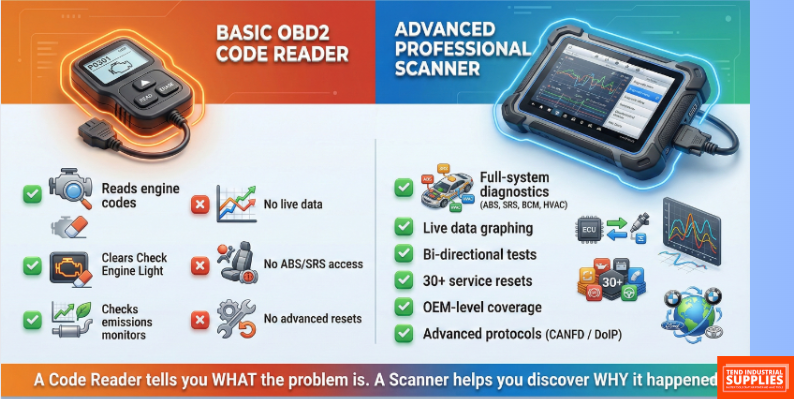
Choosing the Right Tool (Decision Guide)
Choose a Code Reader If You:
-
Only need to know why the Check Engine Light is on
-
Want a simple tool that works instantly
-
Don’t plan to perform deep diagnostics
-
Have a low budget
Choose a Professional Scanner If You:
-
Work on your own vehicles often
-
Need ABS/SRS or transmission diagnostics
-
Want live data for real troubleshooting
-
Need service resets or active tests
The fundamental difference is simple: a code reader tells you what the problem code is, while a professional scanner gives you the tools to figure out why the code was set in the first place. For anyone serious about DIY auto repair, investing in a professional-grade scanner is a significant step toward making faster, more accurate, and more informed repair decisions.
The "Subscription Trap": Warning
In 2025, many "Pro" scanners (like Snap-On or high-end Autel) require an annual fee ($300-$800) just to keep working or get updates.
-
Tip: For DIY use, look for tools that advertise "Lifetime Free Updates" (often found with brands like XTOOL or specialized Vevor units). Don't buy a tool that becomes a paperweight next year.
Frequently Asked Questions
- What is the main difference between a code reader and a professional scanner?
A code reader only reads and clears engine codes, while a professional scanner offers advanced features like live data, ABS/SRS access, and system testing. - Can a basic OBD2 code reader diagnose all car problems?
No, a basic code reader is limited to engine and emissions-related issues. For transmission, ABS, airbag, and in-depth diagnostics, a professional scanner is required. - Is a professional car diagnostic scanner worth the investment for DIY users?
Yes, if you want to perform advanced troubleshooting, monitor real-time data, or service multiple vehicles, a professional scanner provides more value. - Do professional scanners work on all car makes and models?
Most advanced scanners support a wide range of vehicles, but compatibility varies. Always check if the scanner supports your car’s make, model, and year. - How much does a basic code reader cost compared to a professional scanner?
Basic code readers usually cost between $20–$60, while professional scanners range from $200 to over $1,000 depending on features and brand. - Can a professional scanner reset warning lights like ABS and airbag lights?
Yes, unlike basic readers, advanced scanners can reset ABS, SRS (airbag), and other system lights in addition to the check engine light. - Which tool is better for beginners: a code reader or a scanner?
A basic code reader is better for beginners because it’s affordable and easy to use. Advanced scanners are best suited for experienced DIYers or professionals. - Do both code readers and scanners connect through the OBD2 port?
Yes, both tools plug into the OBD2 port, usually located under the dashboard. The difference lies in the depth of information and functions they provide.
Related Articles:
- What is a Car Diagnostic Tool? Your Ultimate Guide to Saving Time & Money
- The 5 Must-Have Diagnostic Scanners for Professional Mechanics in 2025: From Advanced Code Readers to Bi-Directional Tools
- Top 5 Diagnostic Tools Every Mechanic Should Own
- Check Engine Light Codes Explained: P0420, P0300, P0171 & More (DIY Fixes & Costs)
- ANCEL AD310 OBD II Scanner Review: A Must-Have for Car Enthusiasts?
- Best Budget OBD2 Scanners on Amazon in 2025 (Curated by Tend Industrial Supplies)
Conclusion
Choosing between a basic OBD2 code reader and a professional automotive scanner depends on your experience level, your diagnostic goals, and your budget.
If you only need quick insight into a Check Engine Light, a simple code reader is affordable and effective. But if you want deeper troubleshooting, full-system diagnostics, live data, and advanced service functions, investing in a professional-grade car diagnostic scanner is the smarter long-term choice.
Now that you understand the difference between a basic code reader and a professional automotive scanner, it’s time to equip your garage with a tool that matches your needs and skill level. Whether you're identifying a simple engine code or performing full-system troubleshooting, the right tool makes all the difference. Shop smarter. Diagnose faster. Fix with confidence at TendSupplies.com.
Need Help Choosing the Perfect Scanner? Our experts are ready to guide you. Get personalized recommendations, quotes, and professional support.
Please email us:sales@tendsupplies.com.


